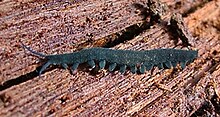Peripatopsidae
Appearance
| Peripatopsidae | |
|---|---|

| |
| Euperipatoides kanangrensis in Australia | |
| Scientific classification | |
| Domain: | Eukaryota |
| Kingdom: | Animalia |
| Phylum: | Onychophora |
| Family: | Peripatopsidae Bouvier, 1907 |
| Genera | |
|
See text | |

| |
| Global range of Onychophora Peripatopsidae extant Peripatidae fossils
| |
Peripatopsidae is one of the two living velvet worm families.[1][2]
Description
The Peripatopsidae exhibit relatively many characteristics that are perceived as original or "primitive" with respect to the Peripatidae. They have between 13 and 25 pairs of legs, behind or between the last of which is the genital opening (gonopore). Both oviparous and ovoviviparous, as well as genuinely viviparous, species exist, although the Peripatopsidae essentially lack a placenta.[citation needed]
Distribution
The distribution of the Peripatopsidae is circumaustral; in particular, they inhabit Australasia, South Africa and Chile.[3]
Genera
The family contains the following genera:[4]
- Acanthokara Reid, 1996
- Aethrikos Reid, 1996
- Aktinothele Reid, 1996
- Anoplokaros Reid, 1996
- Austroperipatus Baehr, 1977
- Baeothele Reid, 1996
- Centrorumis Reid, 1996
- Cephalofovea Ruhberg et al., 1988
- Critolaus Reid, 1996
- Dactylothele Reid, 1996
- Dystactotylos Reid, 1996
- Euperipatoides Ruhberg, 1985
- Florelliceps Tait & Norman, 2001
- Hylonomoipos Reid, 1996
- Konothele Reid, 1996
- Kumbadjena Reid, 2002
- Lathropatus Reid, 2000
- Leuropezos Reid, 1996
- Mantonipatus Ruhberg, 1985
- Metaperipatus Clark, 1913
- Minyplanetes Reid, 1996
- Nodocapitus Reid, 1996
- Occiperipatoides Ruhberg, 1985
- Ooperipatellus Ruhberg, 1985
- Ooperipatus Dendy, 1900
- Opisthopatus Purcell, 1899
- Paraperipatus Ruhberg, 1985
- Paropisthopatus Ruhberg, 1985
- Peripatoides Pocock, 1894
- Peripatopsis Pocock, 1894
- Phallocephale Reid, 1996
- Planipapillus Reid, 1996
- Regimitra Reid, 1996
- Ruhbergia Reid, 1996
- Sphenoparme Reid, 1996
- Tasmanipatus Ruhberg et al. 1991
- Tetrameraden Reid, 1996
- Vescerro Reid, 1996
- Wambalana Reid, 1996
References
Wikimedia Commons has media related to Peripatopsidae.
Wikispecies has information related to Peripatopsidae.
- ^ Oliveira, I.; Hering, L.; Mayer, G. "Updated Onychophora checklist". Onychophora Website. Retrieved 24 November 2016.
{{cite web}}: Unknown parameter|last-author-amp=ignored (|name-list-style=suggested) (help) - ^ "Peripatopsidae (Bouvier, 1907)". Integrated Taxonomic Information System. Retrieved 17 March 2014.
- ^ Oliveira, I. S.; Read, V. M. S. J.; Mayer, G. (2012). "A world checklist of Onychophora (velvet worms), with notes on nomenclature and status of names". ZooKeys. 211: 1–70. doi:10.3897/zookeys.211.3463. PMC 3426840. PMID 22930648.
{{cite journal}}: Unknown parameter|last-author-amp=ignored (|name-list-style=suggested) (help)CS1 maint: unflagged free DOI (link) - ^ "Australian Faunal Directory". Australian Government Department of the Environment. Retrieved 29 June 2016.
